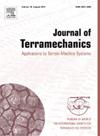用离散元法模拟土-凿-时相互作用
IF 3.7
3区 工程技术
Q3 ENGINEERING, ENVIRONMENTAL
引用次数: 0
摘要
农机化过程中耗能较大的土壤耕作机械的操作参数优化对减少能量投入、提高效率具有重要意义。离散元法(DEM)是一种数值模拟技术,近年来在确定土壤耕作机械运行参数及其对土壤影响的模拟研究中得到了广泛应用。在本研究中,采用DEM模拟来确定不同凿凿时间对土壤和吃水力的影响。将土仓试验结果与DEM模拟结果进行了比较。在两种不同的深度下进行的试验结果表明,20 cm工作深度DEM模拟所得的吃水力与土仓所得吃水力的R、MSE和ε值分别为0.99、6853.59和10.43,28 cm工作深度分别为0.993、8401.974和8.49。变形区的R、MSE和ε值在20 cm工作深度分别为0.997、1375.1和7.04,在28 cm工作深度分别为0.975、3196.75和5.39。本文章由计算机程序翻译,如有差异,请以英文原文为准。
Modelling of soil-chisel tine interactions using the discrete element method
Optimization of operating parameters of soil tillage machines that require high energy in agricultural mechanization processes is of great importance in terms of reducing energy input and increasing efficiency. Discrete element method (DEM), one of the numerical simulation techniques, has been widely used in simulation studies on determining the operating parameters of soil tillage machines and their effects on the soil in recent years. In this study, DEM simulation was used to determine the effect of different chisel tine on the soil and the draft force. The results obtained from the experiments conducted in the soil bin were compared with the DEM simulation. As a result of the tests carried out at two different depths, the R, MSE and ε values determined to compare the draft forces obtained from the DEM simulation and the soil bin were found to be 0.99, 6853.59 and 10.43 for 20 cm working depth, and 0.993, 8401.974, 8.49 for 28 cm working depth, respectively. The values of R, MSE and ε determined for the deformation area were found as 0.997, 1375.1 and 7.04 for 20 cm working depth, and 0.975, 3196.75, 5.39 for 28 cm working depth, respectively.
求助全文
通过发布文献求助,成功后即可免费获取论文全文。
去求助
来源期刊

Journal of Terramechanics
工程技术-工程:环境
CiteScore
5.90
自引率
8.30%
发文量
33
审稿时长
15.3 weeks
期刊介绍:
The Journal of Terramechanics is primarily devoted to scientific articles concerned with research, design, and equipment utilization in the field of terramechanics.
The Journal of Terramechanics is the leading international journal serving the multidisciplinary global off-road vehicle and soil working machinery industries, and related user community, governmental agencies and universities.
The Journal of Terramechanics provides a forum for those involved in research, development, design, innovation, testing, application and utilization of off-road vehicles and soil working machinery, and their sub-systems and components. The Journal presents a cross-section of technical papers, reviews, comments and discussions, and serves as a medium for recording recent progress in the field.
 求助内容:
求助内容: 应助结果提醒方式:
应助结果提醒方式:


